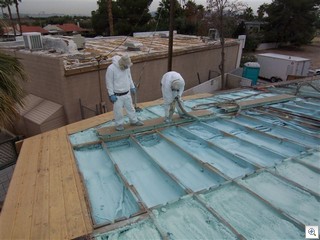Greening The Older Homes Of Las Vegas

I want to thank all of you (about 150 people altogether) who stopped by for the tour of the Revision House. It was a lot of fun, and it was my pleasure to be able to have arranged it. If you’d like to give some feedback, just click on the comments link below.
I learned a lot about how we can spend lots of money to save energy on our “old” houses. The new technologies are terrific, but you have to spend money to save money. Few if any of us are ever going to take a house down to studs and re-do it to the lengths that were taken on the ReVision House. I did learn from some of the experts that the first 20 or 30% of energy savings don’t have to be expensive. In fact they’re downright cheap compared to the savings.
Craig Savage, (the owner of Building Media, who was the driving force behind the ReVision House) and I had several conversations on the subject. He outlined the simple first steps that all homeowners should be taking. Homeowners with 40, 50 and 60 year old homes should especially heed this list. That’s most of us who live in Vintage Vegas.
First, and cheapest, and with the greatest impact is the “weatherization”. CAULK and WEATHERSTRIPPING are our best friends. Craig says that this alone can reduce the energy consumption by 15 to 20%. Any cracks in the stucco or siding are letting in the wind. Gaps between the window frames and the siding or stucco are also big culprits in air penetration. It crawls thru and finds it’s way into the house from under the baseboards and the electrical outlets and anywhere it can get through. I did a real good job caulking up the house before I repainted the outside a few years ago. Have I looked around real well since? Have you? Go take a good look around every window and door. A few tubes of caulk could save a bundle. The US Department of Energy has lots more information, and so does Energy Star and the Consumer Energy Center
Weatherstriping is about air intrusion in the parts of the home that move, such as windows or doors. I’m guilty myself, and really need to follow this advise. My own front door doesn’t seal well when the dead bolt isn’t latched. The whole door needs adjusting, since you have to pull the door tight to latch the dead bolt. If it’s just closed by the doorknob striker, you can see the light around the bottom. At least it finally got me into the habit of locking the deadbolt! What’s your door doing? Here’s some Weatherstripping tips from the Do It Yourself Network.
Craig says the second biggest “bang for the buck” is SEALING THE DUCTWORK. When they do energy audits of a home, they often find that the duct work leaks. When I send our inspector into the attic during the home inspection for new buyers, it’s not uncommon for him to find entire ducts that totally disconnected, and have been blowing hot and cold air into the attic. This isn’t just a leak, it’s a travesty. Recently, Glenn (my favorite inspector, and one of only a handful of “master inspectors” came down from the attic and told us one of the ducts to a bedroom was totally not connected to the vent. The seller was there and said, “we never used that bedroom because it was always too hot or too cold”. It had been that way the entire 10 years he owned the house!
Our older homes were typically built with metal tube ductwork. The individual pieces stick into each other like the attachments of a vacuum cleaner hose. However, they don’t fit well, and lots of heated or cooled air is being blown into the attic or the chases. Duct tape is good for EVERYTHING BUT sealing ducts. Don’t use it. For more information, Check out the duct sealing page from Energy Star or their brochure on the subject in PDF format. HGTV has a Video on duct sealing if you’re willing to watch a commercial first.
 Third on the list is attic insulation. In the ReVision House, they took off the entire roof and sprayed it with foam. It’s really the only practical solution for the flat and low pitched roofs of the typical “desert modern” home. For those with attic space, however, blown in cellulose insulation, or bats of fiberglass are the best solution. The Energy Star website is good place to start learning about insulation.
Third on the list is attic insulation. In the ReVision House, they took off the entire roof and sprayed it with foam. It’s really the only practical solution for the flat and low pitched roofs of the typical “desert modern” home. For those with attic space, however, blown in cellulose insulation, or bats of fiberglass are the best solution. The Energy Star website is good place to start learning about insulation.
Window replacements are actually 4th on the list of improvements for energy conservation. Single pane glass radiates the heat and the cold, but it’s not nearly as bad as cold or hot air penetration that can be fixed with the weatherproofing and duct sealing. Windows are where we start getting into the big money.
Upgraded Heating and Air units are 5th on the list, and also require a big outflow of up front cash. You’d be better served doing the first steps first.



